Looking at all of my 20 Feb 2014 UTC data, the photometry is all over the place.
Why?
There's one hint: the photometry is "better" for targets furthest away from Jupiter.
In this data set, there were four targets: Europa, Ganymede (both near Jupiter -- approx 60 pixels away), Callisto, and a background star (both far away from Jupiter -- approx 185 pixels away) As you can see below, the two nearby targets have
very very very poor photometric continuity, while the two far away targets are more consistent (but still quite terrible):
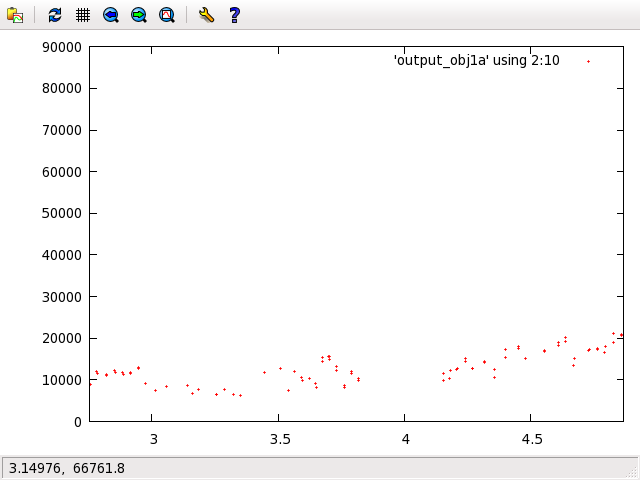 |
| Figure 1: Callisto Photometry |
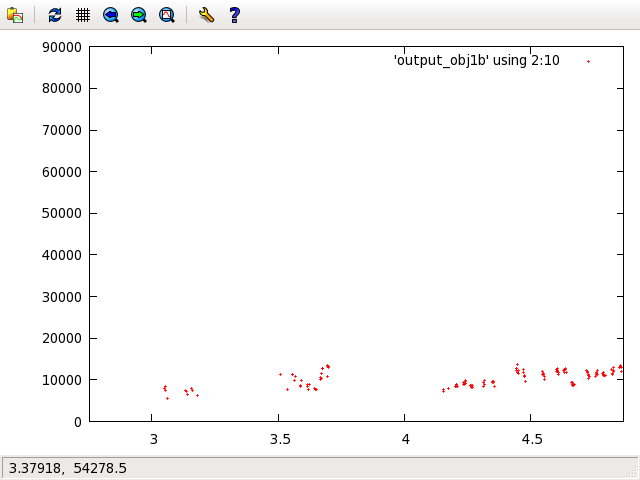 |
| Figure 2: Star Photometry |
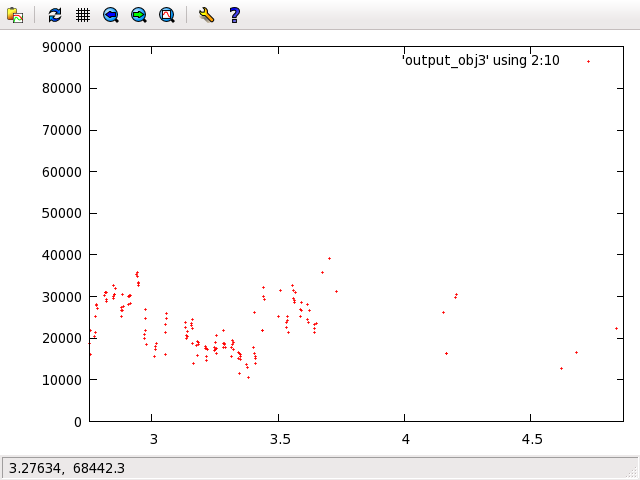 |
| Figure 3: Europa Photometry |
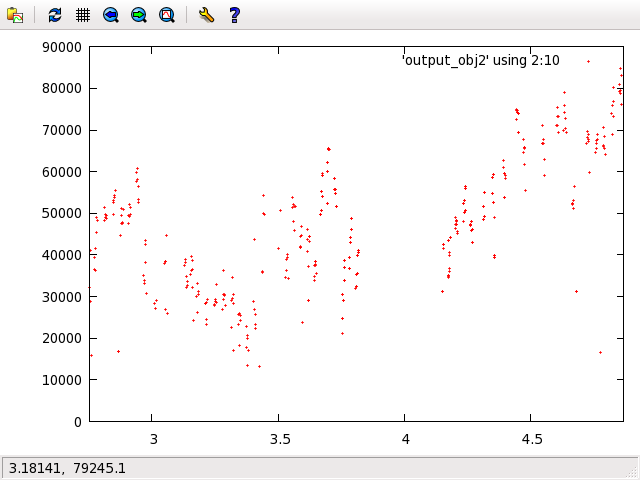 |
| Figure 4: Ganymede Photometry |
Since Europa and Ganymede were so close to each other, their photometry began to mix which is why there's an absense of Europa photometry after about 03:42 UTC and a corresponding "brightenting" in the Ganymede data after that time.
But as you can see from the plots, the scatter with Europa and Ganymede is
totally unacceptable and in fact all of this data as it is right now is totally useless.
However, the big hint is the fact that the quality of the photometry changes in relation to the target's distance to Jupiter. IF this was just due to clouds, I'd expect the shapes of the plots to more or less be the same. I see that to a certain extent, but there are other things going on that can only be due to the "instrumental effects", i.e., internal reflections (see images below in Figure 5), and the fact that Jupiter is such a huge blob.
Looking at the low-level "muck" in some of calibrated images, I see that yes indeed things are very dynamic:
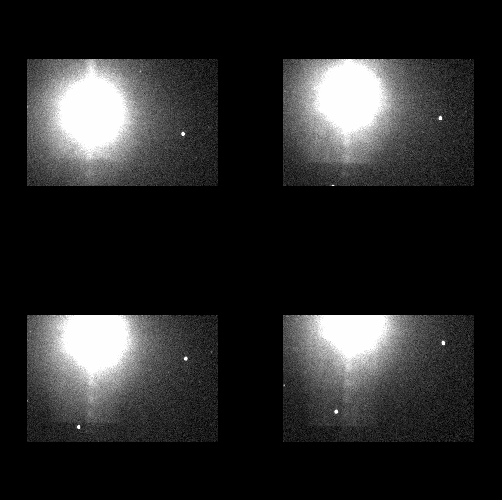 |
| Figure 5: Calibrated Image Samples |
Figure 5 is a sequence of four images taken as the targets scan across the field of view. Jupiter is the bright spot. You can also see Callisto (moving in from the bottom) and the background star (on the right). Europa and Ganymede are hidden in the Jupiter blob.
It's obvious from these images that my photometric measurements are going to change dramatically over time, depending not only on where a single target falls, but also its proximity to Jupiter.
So I have two things to help me move forward and they both have equal priority.
First, model the PSF of Jupiter and subtract it out. Depending on the quality of the fit, I should see a change (hopefully for the better) in the photometry for all four targets.
To test for consistent photometry, I've decided to take a series of at least 200 images of
M35, which is near Jupiter but out of its photometric influence. What I'm hoping to see is consistent photometry. I certainly won't be lacking targets -- which will give my detection software a good workout, too.
The clouds have continued to inhabit the sky over my location, so no new data has been collected.
Frustrated, but still very enthusiastic and hopeful.
======= UPDATE =======
I decided to take a look at some of the images I got back on 13 Feb 2014 UTC when there weren't any clouds, and I now realize that I was dealing with more clouds than what I thought I was.
Below are two more figures, both showing the same raw images. Figure 6 shows a raw image from 13 Feb 2014 UTC (top) and a raw image from 20 Feb 2014 UTC (bottom) with a certain level of contrast/brightness adjustment. It's clear that the 13 Feb image is much sharper and as you can see Jupiter's light is leaking onto the satellites MUCH less. Figure 7 shows the same two images, but I've adjusted the contrast/brightness to bring out the low-level muck. As you can see, the two satellites above Jupiter in the top image (strangely almost the same distance and configuration as the 20 Feb satellites) are still visible while the bottom image shows them completely washed out.
So I'm pretty much worrying over nothing. 20 Feb 2014 UTC showed high clouds the entire time I was taking data and that's the explaination for the poor photometry results.
Having said that, I've located a Gaussian function maker in IRAF that will allow me to model the Jupiter PSF and subtract it out if necessary.
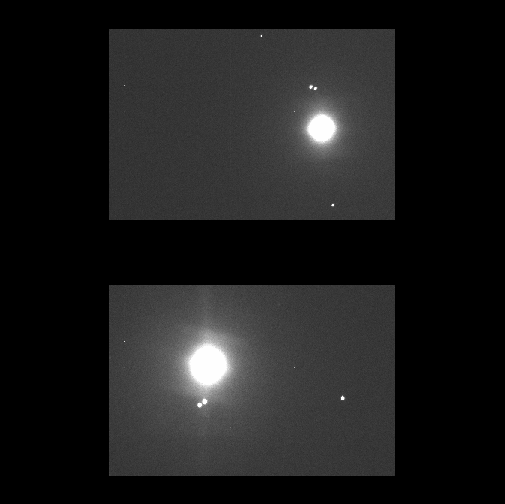 |
| Figure 6: Raw data clear (top) and cloudy (bottom) |
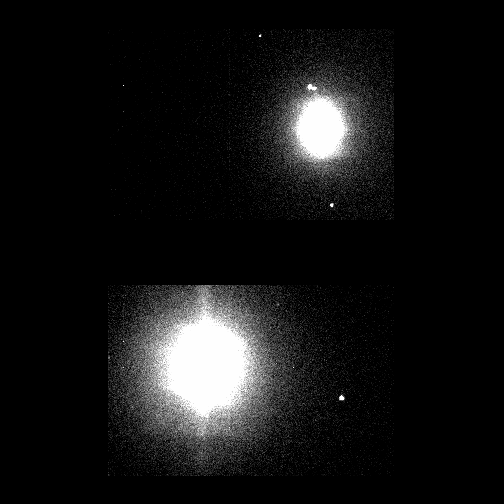 |
| Figure 7: Same as Fig 6, brightness/contrast adjusted |
So yes indeed there is still much hope for this project. Now all I need is some clear sky! Maybe tomorrow night if this new system stays to my south:






























